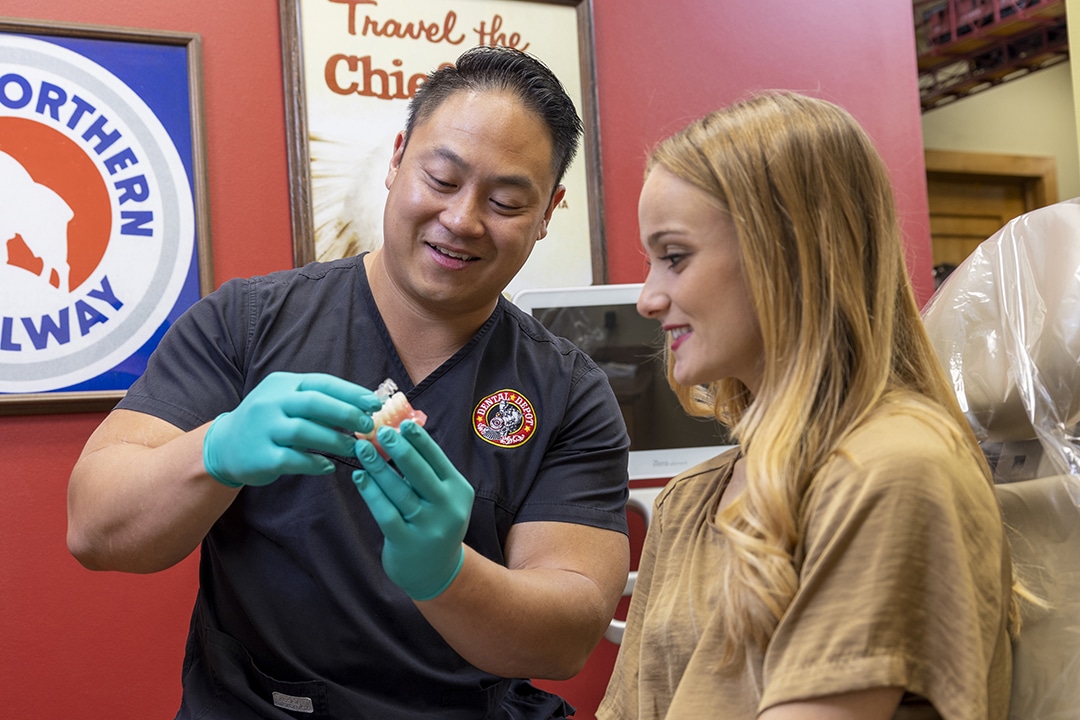Restorations like dental bridges and crowns help ensure your smile stays healthy, strong, and functional. By helping to correct misshapen, damaged, or decayed teeth or replacing missing teeth, dental crowns, and bridges preserve the shape and alignment of your jaw and prevent future problems like infection or bone deterioration.

Crowns and bridges restore oral health and function while preventing further damage. Unlike bones, teeth can’t heal themselves, so once a tooth is cracked, chipped, or decayed, a restoration is vital to protect it. Left untreated, damage can expose sensitive areas to bacteria, leading to infections, abscesses, or the need for extractions. Crowns and bridges help avoid these complications and maintain your smile.
Crowns are tooth-shaped caps that cover damaged teeth or replace missing ones. They’re more extensive than fillings, covering the entire tooth above the gum line, or they’re attached to implants for a natural, secure fit. Crowns also improve aesthetics, correcting misshapen, discolored, or severely damaged teeth.
Bridges replace one or more missing teeth with a row of connected crowns. They’re secured by natural teeth or implants and help restore comfort and confidence when eating or smiling. Options include:
Dental Depot offers affordable, high-quality restorative care at locations across Oklahoma. With Saturday and evening appointments and payment options like SoonerCare and CareCredit, getting the care you need is simple and convenient.
Don’t let tooth damage or loss hold you back. Call your nearest Dental Depot today to explore crowns and bridges and restore your smile!
A crown is used to cap a decayed, damaged, or misshapen tooth at the gum line or to cover a dental implant. A bridge is a set of crowns held together.
Crowns are ideal for teeth that:
Crowns can also be used to anchor dental bridges.
A bridge connects multiple crowns to fill gaps where multiple teeth are missing. Bridges can be attached to adjacent natural teeth or implant-supported. Once placed, a bridge looks, feels, and functions like natural teeth.Bridges are ideal for people who:
The dentists and specialists at Dental Depot can help you determine if a crown or bridge is right for you.
Dental bridges and crowns are not permanent restoration solutions and will need to be replaced eventually. They may also need to be replaced if they become loose or damaged. However, most crowns and bridges are designed to last anywhere from 5 to 15 years or longer, and with proper dental hygiene, including daily brushing and flossing and bi-annual dental check-ups, you can help to extend the longevity of your bridges and crowns.
Signs that your crown or bridge needs to be replaced include:
Bone loss and deterioration in the jaw, or atrophy, occurs where there is nothing to stimulate the jaw, such as a tooth root. Since traditional dental bridges sit above the gum line, they cannot correct bone loss in the jaw. They can, however, keep your natural remaining teeth from shifting, preserving the alignment and structure of your jaw and facial bones so you can still chew, eat, and smile normally.
Implant supported bridges, which attach to small titanium screws placed in the jaw, can help correct bone loss in the jaw, because dental implants act like tooth roots, fusing to the jaw bone.
Crowns and bridges might fall out or break for a variety of reasons. If this happens, it is important that you call your dentist as soon as possible to schedule an appointment; a broken or missing crown or bridge can leave your mouth and teeth susceptible to infection, decay, and shifting. If possible, bring the crown or bridge to the appointment so the dentist can determine if it is still usable. If it is, the dentist may be able to simply reattach it as opposed to creating you an entirely new one. If it isn’t, you may need to have a new crown or bridge made.
A crown refers to a tooth-colored cap that corrects an uneven or chipped tooth. This can be cosmetic or restorative and is fitted to a tooth with an existing root structure.
A dental implant crown is restorative and serves as a replacement for an entire tooth. Dental implant crowns are artificial teeth that are attached to an abutment, which protrudes out of the gum. The abutment itself is attached to a dental implant, which is a small titanium screw implanted into the jaw bone and which acts as a tooth root.
Patients also have options for what materials are used to fabricate their crowns or bridges. Common materials include ceramic, porcelain fused to metal, porcelain, composite resin, and metal alloys. Metals are ideal for budget-conscious patients or replacing teeth at the back of the mouth, while porcelain is ideal for those who want a natural dental restoration. Porcelain fused to metal is also popular, where porcelain serves as a natural-looking complement to your smile without sacrificing the durability of metal.
